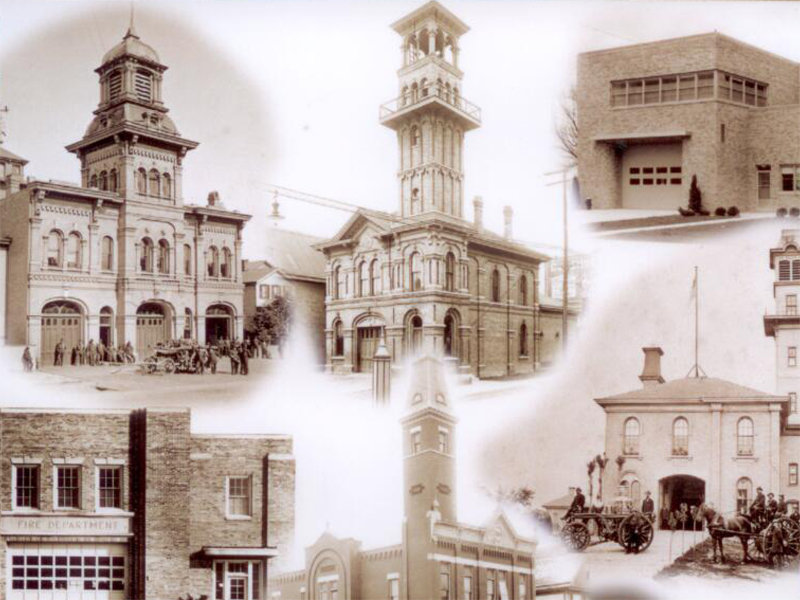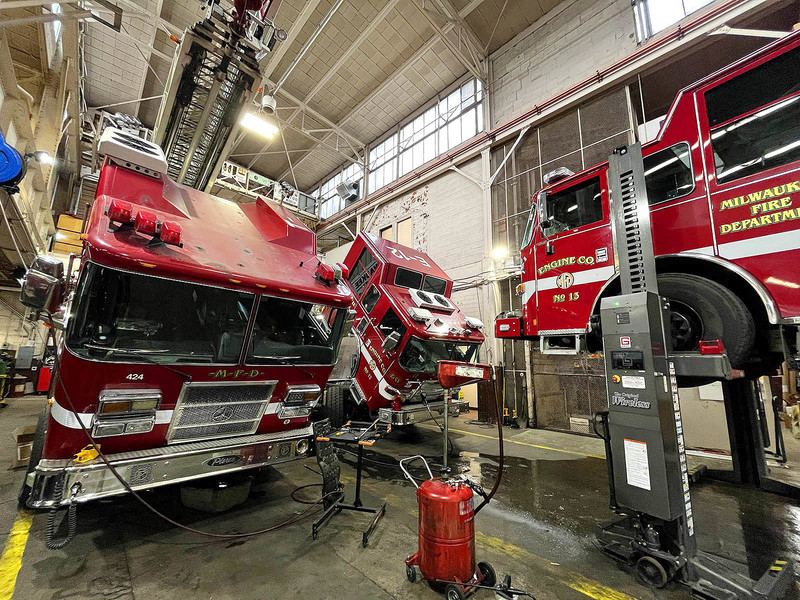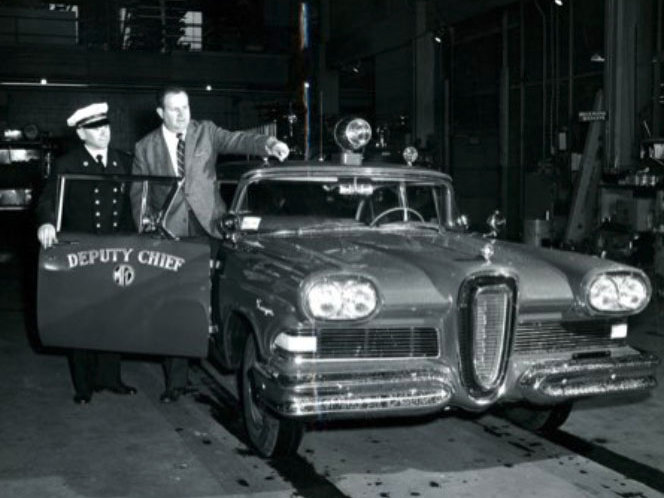There are some books I keep on my desk because they are not only fascinating to page through – with every page you flip to offering some sort of interesting detail on the history of Milwaukee – but also because they’re in-depth founts of knowledge: Larry Widen and Judi Anderson’s "Silver Screens" about Milwaukee cinemas, Russell Zimmermann’s "The Heritage Guidebook," "Beertown Blazes," by James S. Haight and Richard L. Nailen.
Milwaukee Fire Dept. Deputy Chief Jim Ley offers up another one that I will use a lot.
"10-19 Return to Quarters: A History of Milwaukee’s Fire Stations" is an encyclopedic, heavily illustrated, fact-filled, 240-page, indispensable look at the history of firehouses in Milwaukee, from the days of the earliest volunteer crews right up to today.
In addition to the structures themselves, Ley discusses equipment, too, and the men that used it to fight fires for nearly 200 years in Milwaukee. I’m honored that he used a couple photos of mine and thrilled to see he included profiles of architects like Sebastian Brand and Charles Malig.
Just before the holidays, we caught up with Deputy Chief Ley (pronounced "Lie") to ask him about the book and what led him to it.
OnMilwaukee: Give us a little bit about your background as a firefighter and what your position is now.
Jim Ley: I started on the Milwaukee Fire Department in October of 1983. I recently completed 34 years with the department. I have served as a firefighter, heavy equipment operator (driver), lieutenant, captain, battalion chief, and in October I was promoted to deputy chief and assigned to Special Operations.
Special Operations oversees all of the special teams on the department including hazardous materials, heavy urban rescue, fire boat, dive rescue, tactical EMS and the incident command post. I also am the liaison for shared services (with suburban fire departments) and MABAS (Mutual Aid Box Alarm Association). In addition our office plans and staffs for all of the special events in the course of a year such as the air show, numerous runs, stair climbs and polar plunges.
This is not your first book, is it?
I have written four previous books, all fire department-related. An MFD apparatus history, a history of the Wauwatosa FD and two MFD yearbooks.
What led you to write this one?
The new book came about after I saw a series of books written about the Chicago Fire Dept. and their fire stations. I thought with the extensive archives the Milwaukee Fire Historical Society has, we could write something of interest. I wanted to include more than just a bricks and mortar history but include some stories of the men and women who worked in these buildings. Also to showcase the large amount of photos that survive from the early days of the department. The book took just over five years to research and pull photos together.
Were you always fascinated by firehouses and fire trucks as a kid?
My father was a Milwaukee firefighter, so I grew up learning about what a great career the fire service is. I always had an interest in history, especially of Milwaukee so I have been able to mix the two.
What is it that makes these places so intriguing not only to kids but also to adults?
I think what makes firefighting and fire stations intriguing to people is partly the excitement when a call comes in and that most people have some story regarding a firefighter they knew or a fire or EMS call in their past.
You’ve also taken it upon yourself to be the official or unofficial MFD archivist and historian. That must be a lot of work in addition to an already busy work life...
My work as MFD archivist and historian is a hobby that my wife would say is out of control, but it really is something that I enjoy. It is exciting to find new material or learn something new. I recently was given a stack of over 250 photos of MFD apparatus and fire stations taken in the 1960s and it was like getting a great Christmas present.

I was amazed to see how much material survives, especially in comparison to, say, MPD. Why do you think your predecessors had a such a good understanding of the importance of preserving this stuff and this information?
We have been lucky that there have been a number of people interested enough in MFD history to preserve it. In 1982 the department started the Milwaukee Fire Historical Society to archive and preserve things that had been saved.
Were there things you had hoped to find and include that were lost to history?
In doing research for the book, I was hoping to find more information on the volunteer fire department that existed in Milwaukee from 1837 to 1861. I was not able to find any photos of the volunteer firefighters, rigs or buildings. Since firefighters would have made a great picture back in the day and cameras were fairly common by Civil War time it was surprising not to find any. They may exist and I didn’t have the correct sources, so hopefully this book may lead to finding something new.
I imagine a number of these places have very personal memories of...
Firefighters spend a lot of time in the fire station. Some of the busiest companies in Milwaukee may only spend 8 hours in their 24-hour shift in the station, but as a home away from home, they want it to be clean and hospitable. It is a little known fact that the city provides very little furniture, no television, no kitchen utensils, no cable, no newspaper and no food for members. So every member is assessed "house dues" to pay for these amenities.
Do you have plans for future books?
I will probably write another book or two in the future in my retirement.
Where can folks buy the book?
Books are available online. They will also be available at the MFD Fire Museum located at 1615 W. Oklahoma on April 2, between 11 a.m. and 3 p.m. Check Milwaukee Fire Historical Society Facebook page for more info.
Born in Brooklyn, N.Y., where he lived until he was 17, Bobby received his BA-Mass Communications from UWM in 1989 and has lived in Walker's Point, Bay View, Enderis Park, South Milwaukee and on the East Side.
He has published three non-fiction books in Italy – including one about an event in Milwaukee history, which was published in the U.S. in autumn 2010. Four more books, all about Milwaukee, have been published by The History Press.
With his most recent band, The Yell Leaders, Bobby released four LPs and had a songs featured in episodes of TV's "Party of Five" and "Dawson's Creek," and films in Japan, South America and the U.S. The Yell Leaders were named the best unsigned band in their region by VH-1 as part of its Rock Across America 1998 Tour. Most recently, the band contributed tracks to a UK vinyl/CD tribute to the Redskins and collaborated on a track with Italian novelist Enrico Remmert.
He's produced three installments of the "OMCD" series of local music compilations for OnMilwaukee.com and in 2007 produced a CD of Italian music and poetry.
In 2005, he was awarded the City of Asti's (Italy) Journalism Prize for his work focusing on that area. He has also won awards from the Milwaukee Press Club.
He has be heard on 88Nine Radio Milwaukee talking about his "Urban Spelunking" series of stories, in that station's most popular podcast.







